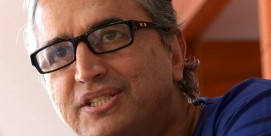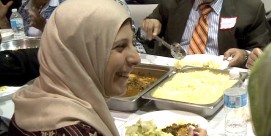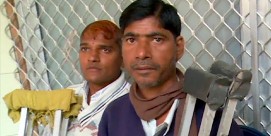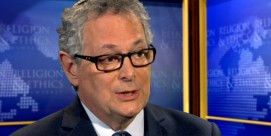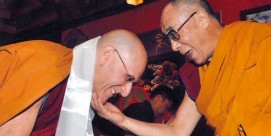In This Episode << SLIDE LEFT TO SEE ADDITIONAL SEGMENTS
Hasten Slowly
Editor’s note: Dr. McCullough died in Maine on June 3, 2016. he was 72.
Excerpted and adapted from remarks by Dennis McCullough, M.D. at an interfaith service, Kendal at Hanover, April 15, 2007
Then the King will say to those at his right hand, “Come O blessed of my Father, inherit the kingdom prepared for you from the foundation of the world; for I was hungry and you gave me food, I was thirsty and you gave me drink, I was a stranger and you welcomed me, I was naked and you clothed me, I was sick and you visited me, I was in prison and you came to me … As you did it to one of the least of my brethren, so also you did it to me.” — Matthew 25:34-36
“Hasten slowly, that you may soon arrive.” — Milarepa (12th-century Tibetan Buddhist holy man)
Almost a thousand years ago, a Tibetan named Milarepa / spoke words that every caregiver would do well to take to heart. / “Hasten slowly,” he said, “that you may soon arrive.” / Hasten slowly, as caregivers and care receivers / that you may reach the destination you each seek / and in the manner you each deserve. / Hasten slowly, and learn the practice of patience, / patience with the person you care for / and patience with yourself. / Hasten slowly, and learn the art of forgiving /as you look into one another’s eyes / and as you see your own face reflected here. / Hasten slowly, and learn the discipline of being sturdy enough to bend / and firm enough to yield. / As you do so, your care giving will assume strength / it would not otherwise have. — From “The Caregiver’s Handbook: Caring for Another, Caring for Yourself” by James E. Miller (Willowgreen Publishing, 2007)
What is there to learn from these readings about the role of the care giver and the role of the cared for?
The passage from Matthew instructs us in the “what” of care giving. It is a central part of the Christian faith and all faiths, embodied in the Golden Rule: Do unto others as you would have them do unto you.
Milarepa’s “hasten slowly” is the perfect companion message to Matthew. It addresses the “how” of quality care giving.
Years ago I worked in the West Indies with Project Hope on a small, rather impoverished island. I spent mornings in village clinics and often used my afternoons to make house calls to remote parts of the island to those who were often homebound and hadn’t seen a doctor in years.
One afternoon, I was called by a family of four elderly siblings in their mid-to-late 80s who were living together and caring for one another. One of the brothers was ill, “but there is no hurry, doctor,” said the runner who summoned me. I was getting the “hasten slowly” message.
Similar judgments are also made in more sophisticated medical settings to proceed with a “slow code” — to “hasten slowly” when it comes to treating patients who would not benefit from resuscitation. Even a medical team expressly trained to resuscitate can come to a tacit understanding and acceptance of the fact that to “hasten slowly” is the humane thing to do.
But today, in large hospitals and care institutions, there seems to be less room for the wise practice of hastening slowly. The resuscitation team arrives, unlikely to know the patient and the situation, and unless a doctor shows up who does know, attempts at resuscitation can go on for a very long time, even in the face of futility.
The slower, more careful, more personal assessment of an individual’s situation is in danger of being lost. Milarepa’s advice to “hasten slowly,” the foundation of humane, compassionate care for those in late life, is steadily under attack in many contemporary institutional care settings.
“Hasten slowly” is a mysterious idea for those of us caught up in a culture of speed and rush and urgency, as the culture of care giving is, particularly when it comes in close contact with contemporary medicine and health care. My sister and I faced a difficult decision with our 92-year-old mother when we moved her away from the pressures of efficiency and speed and routines and “cheerleading” at a nursing home to a residential hospice, where she could follow her own rhythms of sleep and waking, of eating and not eating as she desired. She was closer to her “destination,” as James Miller’s poem about Milarepa suggests — not only to her death (that might well have occurred in the nursing home as she was worn down), but also to the “destination” of being more present in life for her children, for other family and friends, for the staff, and for herself.
The second half Milarepa’s phrase, “that you may soon arrive,” speaks of the Buddhist idea of destination, emphasizing the present moment. We are being told to hasten slowly so that we are fully present in the here and now, with all the awareness and understanding that being fully present brings along with it. Indeed, we can only have this immediate moment. It is all that is available to us.
It is the fully human present-ness that a doctor needs to bring to a resuscitation, not the automatic response based on speed alone. It is the present-ness that allowed my mother to guide her daily schedule. It is the present-ness that is equally true for each of us in all our caring encounters.
My mother’s minister, who visited her regularly in the nursing home, shared with me how difficult it was to sit with her during a visit when she was sleeping and difficult to rouse. The minister said she knew what was needed was simply a period of quiet sitting together, holding my mother’s hand and being with her. But it was so difficult not to be distracted, not to initiate conversation with my mother’s roommate, not to talk to the nurses. So it is for many of us much of the time. We slip away from the moment that is ours for caring.
James Miller’s poem points out that both care givers and care receivers need to learn the art of hastening slowly. It is a two-sided responsibility. Fending off dependency is not the only challenge of aging. It is equally important that care givers extend their imaginations to being dependent. How will we respond? This is an exercise in empathy.
Miller’s poem offers additional advice on how to care:
“That you may reach the destination you each seek and in the manner you each deserve”: The process of care is improved by mutual respect and by both parties being present and listening and slowing down the care process to aid us in getting to this goal.
“Patience with the person you care for and patience with yourself”: Care giving requires consciously breathing deeply in and out and “arriving,” putting yourself into the present, giving space and time to the encounter. Yet how often impatience enters care giving as we focus on forms to be filled out, competing lists of things that need doing, rushing toward the other tasks of the day or, still worse for physicians, facing a computer screen demanding attention.
“Learning the art of forgiving by looking into one another’s eyes”: Everyone has seen famous portraits of the doctor sitting at the bedside, offering comfort to the dying patient. He is also learning to forgive himself — and to ask for forgiveness for what he could not do. So it is for all care givers. We see ourselves and all humanity reflected in the dying person’s face, yet how often we neglect this slow eye contact which underlies forgiveness in our caring encounters.
“Sturdy enough to bend” and “firm enough to yield”: Both care giver and care receiver need to call on an attitude of compromise when facing the demands of care giving and the equally imposing demands of being the receive of care. We are in this together, and we cannot forget that. We are interdependent. We are connected to one another in our families and in our communities.
We will always have to depend on someone else during this journey. Others will always have to depend on us. “Hasten slowly” and continue to seek the destination of being fully present in the moment for one another.

